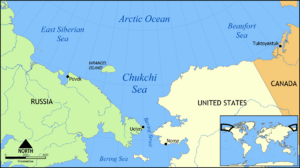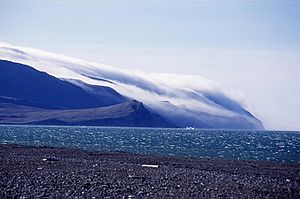Wrangel Island facts for kids
Wrangel Island (Russian: о́стров Вра́нгеля) is a small island in the Arctic Ocean that belongs to Russia. It sits between the Chukchi Sea and the East Siberian Sea. This island is special because the 180° meridian (the line that helps divide the world into east and west) goes right through it. The International Date Line actually moves around the island to avoid it and the nearby Chukchi Peninsula in Russia.
Wrangel Island is about 7,500 square kilometres (2,900 sq mi) in size, which is roughly the same as the U.S. state of Delaware. The closest land is tiny Herald Island, about 60 km (37 mi) to the east. The closest part of the Siberian mainland is 140 km (87 mi) away. Wrangel Island is famous for being a possible last home for Woolly Mammoths. Today, it is home to many arctic animals, including polar bears. Since 1976, it has been a protected nature reserve.
Contents
Exploring Wrangel Island
Early Discoveries
Back in the 1820s, a German explorer named Ferdinand von Wrangel worked for the Russian Empire. He noticed birds flying north from the Kolyma river area. From this, he figured out that there must be an island in the Arctic Ocean. He searched for it but never found it himself.
In 1881, an American steamship called the Thomas L. Corwin was looking for a lost expedition. They ended up near Wrangel Island. They searched the island but didn't find any survivors. They put up an American flag and claimed the island for the United States. They called it "New Columbia," but that name didn't last. For the next 30 years, not much happened with the island.
The Stefansson Expedition
In 1913, Vilhjalmur Stefansson led a big expedition to find a lost continent he thought was under the Arctic ice cap. They sailed from Victoria, British Columbia, but their ship got stuck in the ice six weeks later. Stefansson and some friends left the expedition and went back to safety. When the ship was crushed, the crew made a camp on the ice. In March 1914, Captain Bartlett led the remaining crew 80 miles across the ice to Wrangel Island. Twelve survivors were finally rescued by a small whaling ship in September 1914.
Who Owns the Island?
In 1921, Stefansson claimed Wrangel Island for Canada. An expedition from Canada tried to start a colony there, but it didn't work out. By 1926, Russia took back its claim to the island by setting up its own colony. Eventually, these colonists returned to the mainland, leaving the island empty again.
A Protected Nature Reserve
In 1976, the Soviet Union (which Russia was part of) declared Wrangel Island a zapovednika. This means it's a federally protected nature reserve. In English, it's called the Wrangel Island Nature Reserve. This reserve helps protect large groups of snow geese, polar bears, and walruses that live there. Only Russian government workers and special invited guests are allowed to visit the reserve.
Wrangel's Unique Environment
An Ancient Landscape
Wrangel Island is special because it was never covered by huge glaciers during the last ice ages. It also wasn't covered by water when the ice melted. This means the soil and plants on Wrangel have been untouched for a very long time. The inner valleys are mostly ancient Pleistocene tundra, which is a type of cold grassland. They have over 400 types of plants that are found nowhere else.
Amazing Arctic Wildlife
Even though the weather is very harsh, Wrangel Island has a lot of different animals. It's the world's biggest place for polar bears to make their dens and raise their cubs. About 400 female bears come here to have their young. The island also has the world's largest group of Pacific Walrus.
You can also find many Snow Geese, Snowy Owls, seals, Arctic wolves, Arctic foxes, and lemmings on the island. One interesting thing is that the island seems to be missing mosquitoes!
The Last Woolly Mammoths
Wrangel Island might have been the very last place where Woolly Mammoths (Mammuthus primigenius) lived before they became extinct. The island is covered with mammoth tusks. A group of mammoths lived here for about 6,000 years after they had disappeared from the mainland. They survived until around 1650 BCE. To give you an idea, the Great Pyramids of Giza were already 1,000 years old by then! Archaeological evidence on the island shows that these mammoths were a smaller type, called Mammuth primigenius wrangelensis.
Images for kids
-
Polar bear on Wrangel Island
See also
 In Spanish: Isla de Wrangel para niños
In Spanish: Isla de Wrangel para niños

















